
The standard circulating coinage of the United Kingdom, British Crown Dependencies and British Overseas Territories is denominated in pennies and pounds sterling, and ranges in value from one penny sterling to two pounds. Since decimalisation, on 15 February 1971, the pound has been divided into 100 pence. Before decimalisation, twelve pence made a shilling, and twenty shillings made a pound.
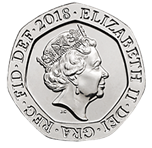
The British decimal twenty pence coin is a denomination of sterling coinage worth 1⁄5 of a pound. Like the 50p coin, it is an equilateral curve heptagon. Its obverse has featured the profile of Queen Elizabeth II since the coin's introduction on 9 June 1982. Four different portraits of the Queen have been used; the latest design by Jody Clark was introduced in 2015. The second and current reverse, featuring a segment of the Royal Shield, was introduced in 2008.
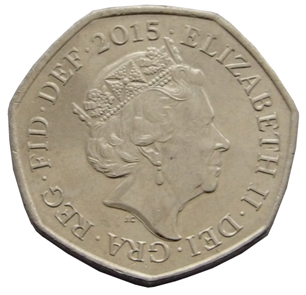
The British decimal fifty pence coin is a denomination of sterling coinage worth 1⁄2 of one pound. Its obverse has featured the profile of the current Monarch since the coin's introduction in 1969. As of October 2022, five different royal portraits have been used.

The British florin, or two-shilling piece, was a coin worth 1⁄10 of one pound, or 24 pence. It was issued from 1849 until 1967, with a final issue for collectors dated 1970. It was the last coin circulating immediately prior to decimalisation to be demonetised, in 1993, having for a quarter of a century circulated alongside the ten-pence piece, identical in specifications and value.
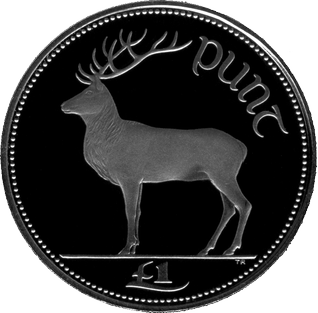
The pound was the currency of Ireland until 2002. Its ISO 4217 code was IEP, and the symbol was £ The Irish pound was replaced by the euro on 1 January 1999. Euro currency did not begin circulation until the beginning of 2002.

Decimal Day in the United Kingdom and in Ireland was Monday 15 February 1971, the day on which each country decimalised its respective £sd currency of pounds, shillings, and pence.
The pound is the currency of Guernsey. Since 1921, Guernsey has been in currency union with the United Kingdom and the Guernsey pound is not a separate currency but is a local issue of sterling banknotes and coins, in a similar way to the banknotes issued in Scotland, England and Northern Ireland. It can be exchanged at par with other sterling coinage and notes.
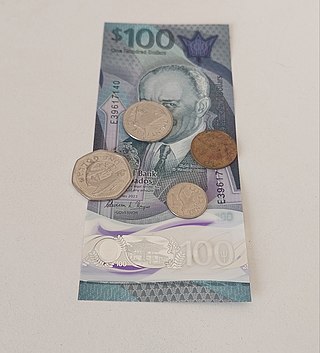
The Barbadian dollar It is often abbreviated to international unofficial abbreviations in Barbados such as: B$, BD$ or the International vehicle registration code BDS$ is also commonly used, a currency code that is otherwise reserved for Bangladesh outside Barbados. As such the present Barbados dollar has the official ISO 4217 code of BB which matches the [dot] .bb Cc-TLD domain names classification for Barbados under ISO 3166, plus D for dollar in the foreign exchange market. The Barbadian dollar is considered as a currency which can be divided into 100 cents, though the 1 cent coin is in the process of being phased out.
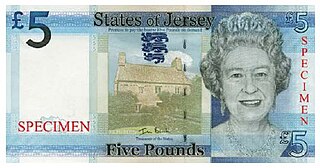
The pound is the currency of Jersey. Jersey is in currency union with the United Kingdom, and the Jersey pound is not a separate currency but is an issue of banknotes and coins by the States of Jersey denominated in sterling, in a similar way to the banknotes issued in Scotland and Northern Ireland. It can be exchanged at par with other sterling coinage and notes.
The pound, or Manx pound, is the currency of the Isle of Man, at parity with sterling. The Manx pound is divided into 100 pence. Notes and coins, denominated in pounds and pence, are issued by the Isle of Man Government.
The Saint Helenapound is the currency of the Atlantic islands of Saint Helena and Ascension, which are constituent parts of the British Overseas Territory of Saint Helena, Ascension and Tristan da Cunha. It is fixed at parity with sterling, and so both currencies are commonly accepted and circulated within Saint Helena. It is subdivided into 100 pence.
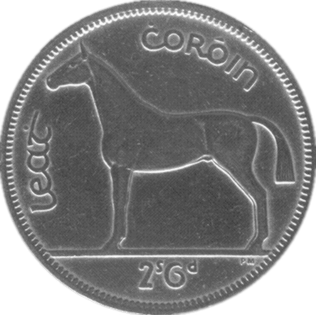
The half crown coin was a subdivision of the pre-decimal Irish pound, worth 1⁄8 of a pound. The half crown was commonly called "two and six" due to its value of two shillings and sixpence.
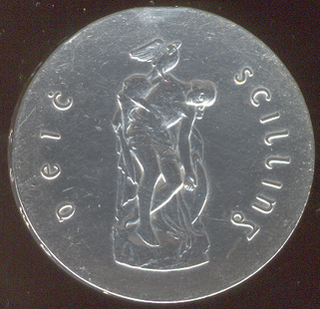
The ten shilling (10s) coin was a one-off commemorative coin issued in Ireland in 1966 to mark the 50th anniversary of the Easter Rising. Ten shillings was a subdivision of the pre-decimal Irish pound, worth 1⁄2 of an Irish pound, making this the highest-value coin in the pre-decimal system.

The decimal halfpenny coin was the smallest denomination of the Irish pound. It was first issued when the Irish currency was decimalised on Decimal Day, 15 February 1971. It was one of three new designs introduced all in bronze and featuring ornamental birds on the reverse. The coin value was weakened by inflation and very few were produced beyond the initial run for 1971. It was removed from circulation and demonetised on 1 January 1987.

The decimal one penny (1p) coin was the second-smallest denomination of the Irish pound. There were 100 pennies (pence) to the pound. The coin was first issued on Decimal Day, 15 February 1971. It was the second of three new designs introduced all in bronze, the others being a half-penny and a two pence coin. All featured ornamental birds designed by Irish artist Gabriel Hayes on the reverse.
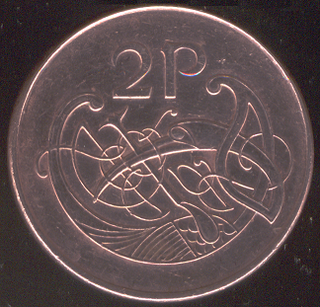
The two pence (2p) coin was the third smallest denomination of the Irish pound, being worth 1⁄50 of a pound. It was first issued on Decimal Day, 15 February 1971. The coin was minted until 2000. It was the third of three new designs introduced all in bronze, the others being the halfpenny and penny. All featured ornamental birds on the reverse.

The five pence (5p) coin was a subdivision of the Irish pound. It was introduced in Ireland on Decimal Day, 15 February 1971 and reused the design on the shilling coin produced for the Irish Free State in 1928. Some shilling coins remained in circulation until the early 1990s, with the same nominal value as the five pence coin.

The ten pence (10p) coin was a subdivision of the Irish pound. It was used in the Republic of Ireland from 1969 to 2002, with its last minting issue in 2000. It replaced the florin coin, of which it shared its design. Two different designs of the coin exist, both featuring a salmon on the reverse. The second was introduced in 1993 and is smaller, due to the reduction of the coin's value by inflation.
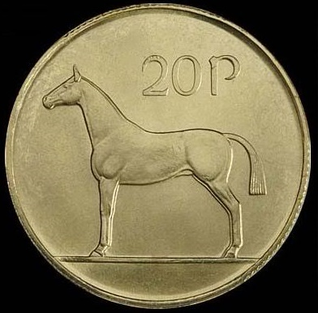
The twenty pence (20p) coin was a subdivision of the Irish pound. It was introduced on 30 October 1986. It was the first Irish decimal coin of a different size to the corresponding British coin, as the Irish pound had not been pegged to sterling since 1979. Its last issue was in 2000, two years before Ireland withdrew its pound for the euro.
There have been three sets of coins in Ireland since independence. In all three, the coin showed a Celtic harp on the obverse. The pre-decimal coins of the Irish punt had realistic animals on the reverse; the decimal coins retained some of these but featured ornamental birds on the lower denominations; and the euro coins used the common design of the euro currencies. The pre-decimal and original decimal coins were of the same dimensions as the same denomination British coins, as the Irish punt was in currency union with the British pound sterling. British coins were widely accepted in Ireland, and conversely to a lesser extent. In 1979 Ireland joined the Exchange Rate Mechanism and the Irish punt left parity with sterling; coin designs introduced after this differed between the two countries.

















